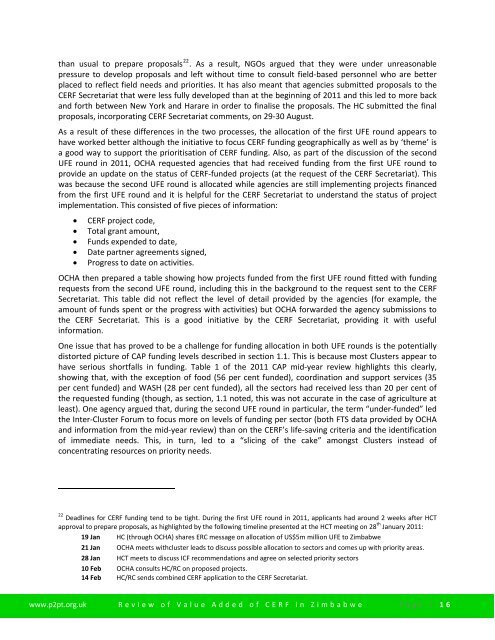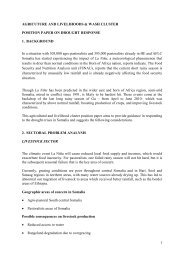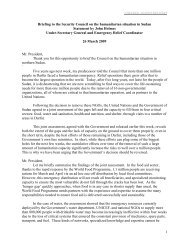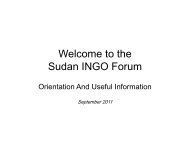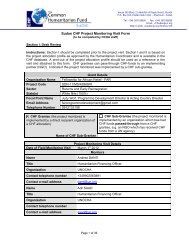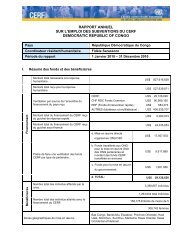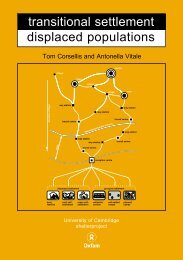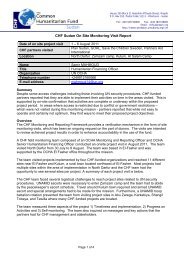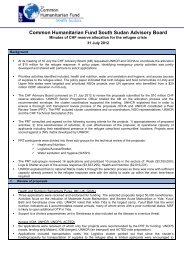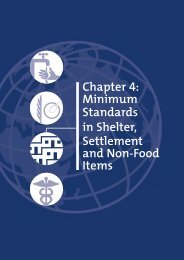in Zimbabwe - OCHANet
in Zimbabwe - OCHANet
in Zimbabwe - OCHANet
Create successful ePaper yourself
Turn your PDF publications into a flip-book with our unique Google optimized e-Paper software.
than usual to prepare proposals 22 . As a result, NGOs argued that they were under unreasonable<br />
pressure to develop proposals and left without time to consult field‐based personnel who are better<br />
placed to reflect field needs and priorities. It has also meant that agencies submitted proposals to the<br />
CERF Secretariat that were less fully developed than at the beg<strong>in</strong>n<strong>in</strong>g of 2011 and this led to more back<br />
and forth between New York and Harare <strong>in</strong> order to f<strong>in</strong>alise the proposals. The HC submitted the f<strong>in</strong>al<br />
proposals, <strong>in</strong>corporat<strong>in</strong>g CERF Secretariat comments, on 29‐30 August.<br />
As a result of these differences <strong>in</strong> the two processes, the allocation of the first UFE round appears to<br />
have worked better although the <strong>in</strong>itiative to focus CERF fund<strong>in</strong>g geographically as well as by ‘theme’ is<br />
a good way to support the prioritisation of CERF fund<strong>in</strong>g. Also, as part of the discussion of the second<br />
UFE round <strong>in</strong> 2011, OCHA requested agencies that had received fund<strong>in</strong>g from the first UFE round to<br />
provide an update on the status of CERF‐funded projects (at the request of the CERF Secretariat). This<br />
was because the second UFE round is allocated while agencies are still implement<strong>in</strong>g projects f<strong>in</strong>anced<br />
from the first UFE round and it is helpful for the CERF Secretariat to understand the status of project<br />
implementation. This consisted of five pieces of <strong>in</strong>formation:<br />
• CERF project code,<br />
• Total grant amount,<br />
• Funds expended to date,<br />
• Date partner agreements signed,<br />
• Progress to date on activities.<br />
OCHA then prepared a table show<strong>in</strong>g how projects funded from the first UFE round fitted with fund<strong>in</strong>g<br />
requests from the second UFE round, <strong>in</strong>clud<strong>in</strong>g this <strong>in</strong> the background to the request sent to the CERF<br />
Secretariat. This table did not reflect the level of detail provided by the agencies (for example, the<br />
amount of funds spent or the progress with activities) but OCHA forwarded the agency submissions to<br />
the CERF Secretariat. This is a good <strong>in</strong>itiative by the CERF Secretariat, provid<strong>in</strong>g it with useful<br />
<strong>in</strong>formation.<br />
One issue that has proved to be a challenge for fund<strong>in</strong>g allocation <strong>in</strong> both UFE rounds is the potentially<br />
distorted picture of CAP fund<strong>in</strong>g levels described <strong>in</strong> section 1.1. This is because most Clusters appear to<br />
have serious shortfalls <strong>in</strong> fund<strong>in</strong>g. Table 1 of the 2011 CAP mid‐year review highlights this clearly,<br />
show<strong>in</strong>g that, with the exception of food (56 per cent funded), coord<strong>in</strong>ation and support services (35<br />
per cent funded) and WASH (28 per cent funded), all the sectors had received less than 20 per cent of<br />
the requested fund<strong>in</strong>g (though, as section, 1.1 noted, this was not accurate <strong>in</strong> the case of agriculture at<br />
least). One agency argued that, dur<strong>in</strong>g the second UFE round <strong>in</strong> particular, the term “under‐funded” led<br />
the Inter‐Cluster Forum to focus more on levels of fund<strong>in</strong>g per sector (both FTS data provided by OCHA<br />
and <strong>in</strong>formation from the mid‐year review) than on the CERF’s life‐sav<strong>in</strong>g criteria and the identification<br />
of immediate needs. This, <strong>in</strong> turn, led to a “slic<strong>in</strong>g of the cake” amongst Clusters <strong>in</strong>stead of<br />
concentrat<strong>in</strong>g resources on priority needs.<br />
22 Deadl<strong>in</strong>es for CERF fund<strong>in</strong>g tend to be tight. Dur<strong>in</strong>g the first UFE round <strong>in</strong> 2011, applicants had around 2 weeks after HCT<br />
approval to prepare proposals, as highlighted by the follow<strong>in</strong>g timel<strong>in</strong>e presented at the HCT meet<strong>in</strong>g on 28 th January 2011:<br />
19 Jan HC (through OCHA) shares ERC message on allocation of US$5m million UFE to <strong>Zimbabwe</strong><br />
21 Jan OCHA meets withcluster leads to discuss possible allocation to sectors and comes up with priority areas.<br />
28 Jan HCT meets to discuss ICF recommendations and agree on selected priority sectors<br />
10 Feb OCHA consults HC/RC on proposed projects.<br />
14 Feb HC/RC sends comb<strong>in</strong>ed CERF application to the CERF Secretariat.<br />
www.p2pt.org.uk Review of Value Added of CERF <strong>in</strong> <strong>Zimbabwe</strong> Page | 16


